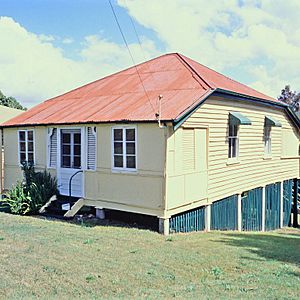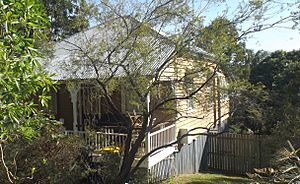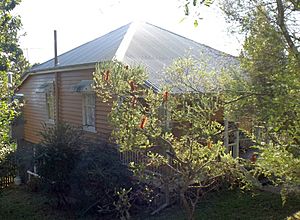Strathearn, Alderley facts for kids
Quick facts for kids Strathearn |
|
|---|---|

Strathearn, 1999
|
|
| Location | 16 Quarry Road, Alderley, City of Brisbane, Queensland, Australia |
| Design period | 1919–1930s (interwar period) |
| Built | 1920–1950s |
| Official name: Strathearn, Anzac Cottage (no.37) | |
| Type | state heritage (built, landscape) |
| Designated | 5 February 2007 |
| Reference no. | 602064 |
| Significant period | 1920s-1950s (fabric) 1920s (historical) |
| Significant components | garden/grounds, trees/plantings, residential accommodation – main house |
| Lua error in Module:Location_map at line 420: attempt to index field 'wikibase' (a nil value). | |
Strathearn is a special old house in Alderley, a suburb of Brisbane, Australia. It's known as a heritage-listed cottage, which means it's important to Queensland's history and is protected. This small timber house was built between 1920 and 1950. It's also called Anzac Cottage (number 37) because it was built for the family of a soldier who fought in World War I. Strathearn was added to the Queensland Heritage Register on 5 February 2007.
Contents
What is an Anzac Cottage?
After World War I (1914-1918), many soldiers were hurt or died. People in Australia wanted to help their families. One way they did this was by building special homes called Anzac Cottages. These homes were often built on land that was given for free. Volunteers helped to build them. The first Anzac Cottage was likely built in Western Australia in 1916.
How the Anzac Cottages Helped Families
In Queensland, a group called the Anzac Cottage Trust was set up in 1915. Their main goal was to find land and build homes for widows (women whose husbands had died) or other female family members of soldiers who died in World War I. This committee also chose who would live in these homes.
The rules for living in an Anzac Cottage were strict. The widow had to be of "good character" and stay single. She also had to pay for bills, local taxes, and house insurance. She needed to keep the house in good condition. The land for the cottages was owned by the Public Curator, who managed it for the Trust. The money from rent helped to pay for the upkeep of these homes.
If a widow remarried or a child grew up and married, they usually had to move out. However, if a child could care for the family after the widow died, they might be allowed to stay.
How Anzac Cottages Were Funded
Many Anzac Cottages in Queensland were paid for by money from the "Golden Casket" lottery. This was a special lottery in Queensland. Numbers three, four, and five of the Golden Casket lottery helped fund these homes. Harry Coyne, who led the Anzac Cottage Committee, was very involved in this idea. These lotteries offered big prizes, which encouraged many people to buy tickets. The money raised helped build between 60 and 80 homes for war widows.
Strathearn's Story
Thirty-eight Anzac Cottages were built in Brisbane. Many of them had names linked to the Anzac theme, like Kitchener or Monash. Strathearn was the second-to-last cottage built, number 37. It was built at 16 Quarry Road, Alderley.
The Warner Family at Strathearn
The Warner family was the first to live in Strathearn. John Thomas Warner was a soldier who fought in World War I. He was buried in a shell explosion in 1917 and sent home. Sadly, he died in March 1920.
His widow, Mrs. Mary Ann Warner, and her five children moved into Strathearn in July 1920. Soon after, her son Jack was born there. Mrs. Warner loved gardening. It became a family tradition to use a piece of sacred bamboo from her garden in wedding bouquets. Each family member also received a cutting to plant when they moved into a new home.
Mrs. Warner passed away in her garden in 1955. Her daughter, Mrs. Florence Richardson Handley, then moved back into the house. Florence's husband had been a prisoner of war in World War II and died when his Japanese transport ship was sunk.
Strathearn remained a special place for family events, like Christmas Day, until Florence Handley died in 1998. After that, the house was empty for a while.
Changes to the Anzac Cottage Scheme
The Anzac Trust Committee stopped in 1932. All the responsibility for the cottages went to the Public Curator (later called the Public Trustee). By 1956, fewer World War I widows needed homes. Many cottages were rented to other families.
The fund for maintaining the cottages also ran into financial trouble. Because of this, a law was passed in 1960 called the Anzac Cottages & TB Homes Act. This law allowed some Anzac Cottages to be sold to help pay for repairs to the ones still being rented. By 1963, thirteen cottages had been sold. Strathearn was the only Anzac Cottage that the Public Trustee was still in charge of in 1999. It was eventually sold in September 2000.
What Strathearn Looks Like
Strathearn is a single-story house made of timber weatherboards. It has a short, ridged roof made of corrugated iron. The house sits on a high spot, and from the back windows, you can see towards the Enoggera Army Barracks and the hills.
The front of the house has a verandah, which is like a porch. This verandah has been closed in with fibro sheeting. The main entrance is in the middle, with two timber steps leading up to it. It has casement doors that open outwards. Next to these doors are louvred windows that let air in. There's also a casement window on each side of the main entry. The sides of the enclosed verandah also have louvred openings.
The sides of the house have two-paned sash windows, which slide up and down. Metal shades are above these windows and also cover the kitchen window at the back.
Because the land slopes, the back of the house is built higher off the ground. It stands on concrete posts with timber slats in between. A timber staircase leads to the back of the house. Above these stairs on the back wall are three more casement windows.
Inside, the front door opens into a hallway. This hallway separates two bedrooms at the front of the house and leads into the sitting room. The kitchen and dining room are at the back. The house originally had three bedrooms, but one has been changed into a bathroom.
There are many plants and trees at the back and on the southern side of the house.
Why Strathearn is Important
Strathearn is listed on the Queensland Heritage Register because it meets several important criteria.
A Piece of Queensland's History
Strathearn shows an important part of Queensland's history. It was built as part of the Anzac Cottage Scheme. This scheme provided homes for the families of Queensland soldiers and sailors who died in World War I. These homes were paid for using money from the Queensland lottery.
A Rare Example
Strathearn is special because it was one of the last Anzac Cottages managed by the Public Trustee. This makes it a rare example of this type of heritage.
Showing What an Anzac Cottage Is
The house is still in its original condition. This means it clearly shows what an Anzac Cottage was like.
Its Look and Feel
Strathearn also adds to the beauty of Quarry Road. Its design and setting make it an important part of the streetscape.
Connecting with the Community
The house has a strong link to the Queensland community. It shows how people supported the families of those who died in World War I.
Linked to Important Groups
Strathearn is connected to the work of the Anzac Cottage Trust. This group was a part of the Queensland War Council. The house also has a special link to the Queensland lottery, as the lottery's profits helped build many of these cottages.



